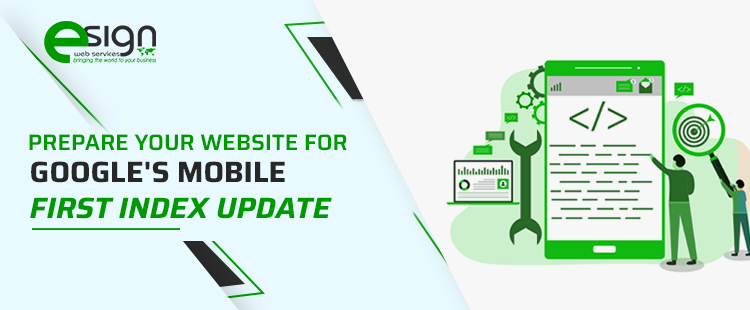How to Prepare Your Website for Google’s Mobile-First Index Update

Mobile-first indexing means Google predominantly uses the mobile version of the content for indexing and ranking. Historically, the index primarily used the desktop version of a page’s content when evaluating the relevance of a page to a user’s query. Since the majority of users now access Google Search with a mobile device, Googlebot primarily crawls and indexes pages with the smartphone agent going forward.
Since many people use their mobile devices to search, it will be the new way to search, even from a desktop. This means that many websites may need to update their sites to get seen. As of now, Google shows the web from a desktop’s point of view. Being mobile-friendly makes SEO better for the site. However, the content of a mobile site doesn’t make a difference in its SERP rankings at this time. Google has shown that more searches were done through mobile devices than on desktops all over the world. Google wants to ensure that it gives mobile users a good experience. And going to a mobile-first index will do that.
There are a great many things to keep in mind when thinking about mobile site speed. Not all mobile sites are built for speed because of their design. Some have images that are too big and take too long to load because they are the same images presented on the desktop site. On the desktop, they load just fine. However, on the mobile site, they take forever and take up the whole screen. These must be adjusted. Other things include coding. You need to code your page in certain ways for the speed to measure up. If it doesn’t, then you have to go in and make sure that everything is up to par. Otherwise, it will slow down your speed and your mobile site will not be a success, even if your desktop site is.
A mobile responsive design is necessary because it keeps the site consistent. This happens no matter what device someone is using to view your site. Your HTML doesn’t change. What does change is your CCS, so that your site looks good on a variety of screens. It also solves technical issues. A mobile responsive design may solve most of the steps on this list.
Make The Site Both Mobile-Friendly and Mobile-Optimized
It’s not enough to make your site mobile-friendly. Just because a site can be seen on a mobile device doesn’t mean that it is good enough for the new mobile-first index. It has to be mobile optimized. This means that it works with the mobile device first and can show everything on the mobile device that it would on the desktop. It must run smoothly and quickly.
Keep your Primary Content on your Mobile Site
Make sure that the content you have on your desktop is the same as the content you have on your mobile site. Whatever users can find on your desktop page should also be found on your mobile site. Google won’t penalize you after the change for hiding content. This means you can use tabs and accordions. It’s important to use these on mobile sites because they keep the site organized and easy to go through. You have to ensure, however, that the content is simple to find and labeled accordingly.
Modify your Content For Mobile Displays
You want the same content on your mobile page that you have on your desktop. This includes pictures, videos, and graphics. You want to be able to crawl and index all of the formats used on the mobile site. However, you want your content to be mobile-friendly. Use short sentences and paragraphs. A simple and clean layout is best. Continue to consider SEO keywords, since Google will still be using them. Pay attention to how big your images are. You don’t want to overwhelm the mobile sites with huge pictures. Large images may also slow down your mobile site.
Keep Certain Technical Details in Mind
Make sure that all of your sections are easy to find on your site. Ensure that all of your internal links are up and running. Dead or non-functional links will keep Google’s crawlers from properly indexing your pages and it will look bad to your visitors who are trying to follow your links. Check your structured data. It tells Google about your page and organizes your info in SERPs. Watch markup, however, since it may slow down your site. When it comes to metadata, you want equivalent titles and descriptions.
Hreflang should point to the mobile version of your site. When it comes to XML and media sitemaps, the links should be accessible from the mobile version. Social metadata ought to be on both the mobile and the desktop versions. If you have app indexation on the desktop version, ensure you have verified the mobile version. Switchboard tags do not need to be changed. Search console verification needs to be done for the mobile version if you only have it done for the desktop version.
Increase The speed of your Mobile Site
When considering SEO, site speed has always been critical. It’s especially important with a mobile-first index. If the site takes more than three seconds to load, a user is likely to leave it. Your back-ending code, the weight of your content, and others are important details to keep in mind.
Backlinks are Still Important
Your score in Google still accounts for your linking. So keeping your backlinks is still vital to the overall success of your site. Poor quality sites will destroy your score with Google. SEMRush is a tool you can use to see who is linking to you. Remove any bad links by using the disavow tool. Use this tool only if the links appear to be spam. You want to make sure you keep all of your good links because they are very important in bringing traffic to your site.
Nothing is Hidden in a Mobile Version for Google to Judge your Text
You want everything on your site to be seen by Google. Google must be able to judge your text for SEO to work. In this way, you will get Google to point users directly to your site using keywords. For instance, if you have certain keywords on your desktop that are leading people there, but your mobile site is lacking these things, Google will not direct people to your mobile site as they do to your desktop site.
Run Tests to See if The Changes are Working
Google has master tools to help you run tests. You can use the Mobile-Friendly test to check the mobile-friendliness of your site. The Structured Data Testing Tool will check your structured markup for errors. Fetch as Google will let you see the site as if you were a crawler. This way you can see if everything is visible that you want. Google’s PageSpeed Insight Tools will help you check the speed of your site.
Conclusion
To conclude, mobile-first indexing may be the next step in Google’s search engines, but it will take some preparation on the part of web designers. If you already have a mobile site, great. You just have to optimize it for the best search possible. If you don’t have one, now is the time to make one. More people are using their mobile devices to search now than ever before. A mobile-friendly design isn’t just going to cut it. You need a mobile responsive design. If you already have one, then you need not do anything else. If, however, your site isn’t up to par, then it’s time to get it there.
Also, take care to think about mobile speed. The faster your page loads, the more likely people are to go to it. You want a mobile-optimized site. So increase your speed. Keep your primary content on your mobile page that is also on your desktop page. You don’t want to lose that content. However, make sure that it is mobile-friendly. Size down pictures and graphics so that they don’t take up speed and room on the mobile screen. Keep those technical details in mind that will make running your mobile site easier and faster. They will be the things that propel your site to the next level.
Don’t forget about backlinks though since they are the lifeblood of your traffic. People come in through your backlinks. However, you want to get rid of any links that are spammy or bad. Those will lower your ratings. Don’t hide anything from Google. Anything that is on your desktop page should also appear on your mobile site. And lastly, run tests. These will determine if your mobile site is good to go. Don’t be afraid of this new system. It’s not your enemy. With these simple steps, you can dominate the internet with your new mobile site just like you have been with your desktop site.


